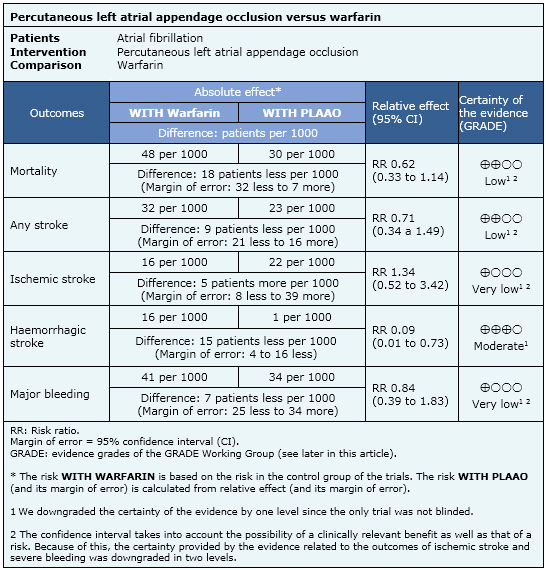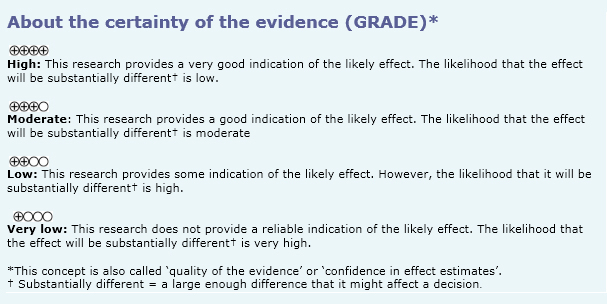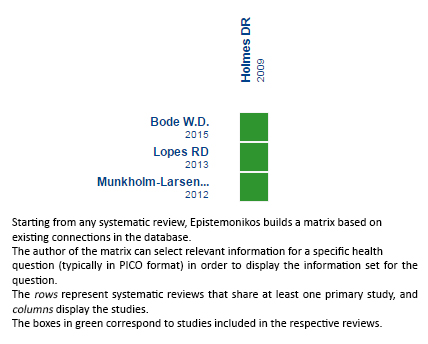 Para Descargar PDF debe Abrir sesión.
Para Descargar PDF debe Abrir sesión.
For most atrial fibrillation patients oral anticoagulation constitutes the standard treatment to prevent stroke. However, they carry a risk of bleeding, which is why alternative treatments have been put into practice, such as percutaneous closure of the left atrial appendage. It is not clear whether this is as effective as the conventional treatment with anticoagulants. Searching in Epistemonikos database, which is maintained by screening 30 databases, we identified three systematic reviews including only one pertinent randomized controlled trial. We combined the evidence and generated a summary of findings following the GRADE approach. We concluded that percutaneous left atrial appendage occlusion may decrease stroke and mortality, but the certainty of the evidence is low. The effect on other outcomes is not clear because the certainty of the evidence is very low.
Stroke is one of the most serious complications of atrial fibrillation. The left atrial appendage is the source of more than 90% of clots in the case of patients with non-valvular atrial fibrillation, which is why the percutaneous closure of the left atrial appendage has become an interesting alternative to the conventional treatment with oral anticoagulants. Despite being a minimally invasive procedure, it may present complications such as severe bleeding and pericardial effusion, among others.
We used Epistemonikos database, which is maintained by screening more than 30 databases, to identify systematic reviews and their included primary studies. With this information we generated a structured summary using a pre-established format, which includes key messages, a summary of the body of evidence (presented as an evidence matrix in Epistemonikos), meta-analysis of the total of studies, a summary of findings table following the GRADE approach and a table of other considerations for decision-making.
|
Key messages
|
|
What is the evidence. |
We found three systematic reviews [1],[2],[3] including only one randomised controlled trial [4]. |
|
What types of patients were included |
Mean age of patients was 71 years old, with a CHADS2 score for atrial fibrillation stroke risk of 2.2. None of the patients had contraindication to oral anticoagulation. |
|
What types of interventions were included |
This study compared the percutaneous closure of the atrial appendage with warfarin treatment. Patients allocated to the intervention group received percutaneous closure of the left atrial appendage by use of the WATCHMAN device. This device is a self-expanding nickel titanium frame structure with a permeable polyester fabric cover, ranged in diameter from 21 mm to 33 mm. The implantation was guided by flouroscopy and transesophageal echocardiography to verify proper positioning and stability. After the device had been implanted, patients were treated with warfarin for 45 days to facilitate device endothelialization. After stopping warfarin treatment, once daily clopidogrel and aspirin were prescribed until completion of the 6-month follow up visit, from which point aspirin alone was continued indefinitely. For the control group, plasma warfarin concentration was in the therapeutic INR range (between 2.0 and 3.0) 66% of the time. |
|
What types of outcomes |
Primary efficacy (ischemic stroke, hemorrhagic stroke, cardiovascular/unexplained death, systemic embolism), any stroke, all-cause mortality. Primary safety: events related to excessive bleeding (i.e. intracranial or gastrointestinal bleeding) or procedure-related complications (i.e. serious pericardial effusion, device embolization, procedure-related stroke). Mean follow-up per patient was 18 months. |
The information on the effects of percutaneous left atrial appendage closure is based on one randomized controlled trial including 707 patients.


|
To whom this evidence does and does not apply |
|
| About the outcomes included in this summary |
|
| Balance between benefits and risks, and certainty of the evidence |
|
| Resource considerations |
|
|
Differences between this summary and other sources |
|
| Could this evidence change in the future? |
|
Using automated and collaborative means, we compiled all the relevant evidence for the question of interest and we present it as a matrix of evidence.
Matrix of evidence (static version).
Follow the link to access the interactive version: Percutaneous atrial appendage occlusion versus warfarin for atrial fibrillation
The upper portion of the matrix of evidence will display a warning of “new evidence” if new systematic reviews are published after the publication of this summary. Even though the project considers the periodical update of these summaries, users are invited to comment in Medwave or to contact the authors through email if they find new evidence and the summary should be updated earlier. After creating an account in Epistemonikos, users will be able to save the matrixes and to receive automated notifications any time new evidence potentially relevant for the question appears.
The details about the methods used to produce these summaries are described here http://dx.doi.org/10.5867/medwave.2014.06.5997.
Epistemonikos foundation is a non-for-profit organization aiming to bring information closer to health decision-makers with technology. Its main development is Epistemonikos database (www.epistemonikos.org).
These summaries follow a rigorous process of internal peer review.
Conflicts of interest
The authors do not have relevant interests to declare.

 Matrix of evidence (static version).
Matrix of evidence (static version).
 Esta obra de Medwave está bajo una licencia Creative Commons Atribución-NoComercial 3.0 Unported. Esta licencia permite el uso, distribución y reproducción del artículo en cualquier medio, siempre y cuando se otorgue el crédito correspondiente al autor del artículo y al medio en que se publica, en este caso, Medwave.
Esta obra de Medwave está bajo una licencia Creative Commons Atribución-NoComercial 3.0 Unported. Esta licencia permite el uso, distribución y reproducción del artículo en cualquier medio, siempre y cuando se otorgue el crédito correspondiente al autor del artículo y al medio en que se publica, en este caso, Medwave.

For most atrial fibrillation patients oral anticoagulation constitutes the standard treatment to prevent stroke. However, they carry a risk of bleeding, which is why alternative treatments have been put into practice, such as percutaneous closure of the left atrial appendage. It is not clear whether this is as effective as the conventional treatment with anticoagulants. Searching in Epistemonikos database, which is maintained by screening 30 databases, we identified three systematic reviews including only one pertinent randomized controlled trial. We combined the evidence and generated a summary of findings following the GRADE approach. We concluded that percutaneous left atrial appendage occlusion may decrease stroke and mortality, but the certainty of the evidence is low. The effect on other outcomes is not clear because the certainty of the evidence is very low.
 Autores:
Thomas Uslar[1], Jaime Anabalón[1,2,3]
Autores:
Thomas Uslar[1], Jaime Anabalón[1,2,3]

Citación: Uslar T, Anabalón J. Is percutaneous closure of the left atrial appendage comparable to anticoagulants for atrial fibrillation?. Medwave 2015;15(Suppl 2):e6218 doi: 10.5867/medwave.2015.6218
Fecha de publicación: 17/8/2015

Nos complace que usted tenga interés en comentar uno de nuestros artículos. Su comentario será publicado inmediatamente. No obstante, Medwave se reserva el derecho a eliminarlo posteriormente si la dirección editorial considera que su comentario es: ofensivo en algún sentido, irrelevante, trivial, contiene errores de lenguaje, contiene arengas políticas, obedece a fines comerciales, contiene datos de alguna persona en particular, o sugiere cambios en el manejo de pacientes que no hayan sido publicados previamente en alguna revista con revisión por pares.
Aún no hay comentarios en este artículo.
Para comentar debe iniciar sesión
 Medwave publica las vistas HTML y descargas PDF por artículo, junto con otras métricas de redes sociales.
Medwave publica las vistas HTML y descargas PDF por artículo, junto con otras métricas de redes sociales.
 Bode WD, Patel N, Gehi AK. Left atrial appendage occlusion for prevention of stroke in nonvalvular atrial fibrillation: a meta-analysis. J Interv Card Electrophysiol. 2015 Jun;43(1):79-89. | CrossRef | PMC |
Bode WD, Patel N, Gehi AK. Left atrial appendage occlusion for prevention of stroke in nonvalvular atrial fibrillation: a meta-analysis. J Interv Card Electrophysiol. 2015 Jun;43(1):79-89. | CrossRef | PMC | Lopes RD, Crowley MJ, Shah BR, Melloni C, Wood KA, Chatterjee R, et al. Stroke Prevention in Atrial Fibrillation. Rockville (MD), US: Agency for Healthcare Research and Quality; 2013 | Link |
Lopes RD, Crowley MJ, Shah BR, Melloni C, Wood KA, Chatterjee R, et al. Stroke Prevention in Atrial Fibrillation. Rockville (MD), US: Agency for Healthcare Research and Quality; 2013 | Link | Munkholm-Larsen S, Cao C, Yan TD, Pehrson S, Dixen U. Percutaneous atrial appendage occlusion for stroke prevention in patients with atrial fibrillation: a systematic review. Heart. 2012 Jun;98(12):900-7. | CrossRef | PubMed |
Munkholm-Larsen S, Cao C, Yan TD, Pehrson S, Dixen U. Percutaneous atrial appendage occlusion for stroke prevention in patients with atrial fibrillation: a systematic review. Heart. 2012 Jun;98(12):900-7. | CrossRef | PubMed | Holmes DR, Reddy VY, Turi ZG, Doshi SK, Sievert H, Buchbinder M, et al. Percutaneous closure of the left atrial appendage versus warfarin therapy for prevention of stroke in patients with atrial fibrillation: a randomised non-inferiority trial. Lancet. 2009 Aug 15;374(9689):534-42. | CrossRef | PubMed |
Holmes DR, Reddy VY, Turi ZG, Doshi SK, Sievert H, Buchbinder M, et al. Percutaneous closure of the left atrial appendage versus warfarin therapy for prevention of stroke in patients with atrial fibrillation: a randomised non-inferiority trial. Lancet. 2009 Aug 15;374(9689):534-42. | CrossRef | PubMed | Skanes AC, Healey JS, Cairns JA, Dorian P, Gillis AM, McMurtry MS, et al. Focused 2012 update of the Canadian Cardiovascular Society atrial fibrillation guidelines: recommendations for stroke prevention and rate/rhythm control. Can J Cardiol. 2012 Mar-Apr;28(2):125-36. | CrossRef | PubMed |
Skanes AC, Healey JS, Cairns JA, Dorian P, Gillis AM, McMurtry MS, et al. Focused 2012 update of the Canadian Cardiovascular Society atrial fibrillation guidelines: recommendations for stroke prevention and rate/rhythm control. Can J Cardiol. 2012 Mar-Apr;28(2):125-36. | CrossRef | PubMed | January CT, Wann LS, Alpert JS, Calkins H, Cigarroa JE, Cleveland JC Jr, et al. 2014 AHA/ACC/HRS guideline for the management of patients with atrial fibrillation: a report of the American College of Cardiology/American Heart Association Task Force on Practice Guidelines and the Heart Rhythm Society. J Am Coll Cardiol. 2014 Dec 2;64(21):e1-76. | CrossRef | PubMed |
January CT, Wann LS, Alpert JS, Calkins H, Cigarroa JE, Cleveland JC Jr, et al. 2014 AHA/ACC/HRS guideline for the management of patients with atrial fibrillation: a report of the American College of Cardiology/American Heart Association Task Force on Practice Guidelines and the Heart Rhythm Society. J Am Coll Cardiol. 2014 Dec 2;64(21):e1-76. | CrossRef | PubMed | Camm AJ, Lip GY, De Caterina R, Savelieva I, Atar D, Hohnloser SH, et al. 2012 focused update of the ESC Guidelines for the management of atrial fibrillation: an update of the 2010 ESC Guidelines for the management of atrial fibrillation. Developed with the special contribution of the European Heart Rhythm Association. Eur Heart J. 2012 Nov;33(21):2719-47. | CrossRef | PubMed |
Camm AJ, Lip GY, De Caterina R, Savelieva I, Atar D, Hohnloser SH, et al. 2012 focused update of the ESC Guidelines for the management of atrial fibrillation: an update of the 2010 ESC Guidelines for the management of atrial fibrillation. Developed with the special contribution of the European Heart Rhythm Association. Eur Heart J. 2012 Nov;33(21):2719-47. | CrossRef | PubMed | Landmesser U, Holmes DR Jr. Left atrial appendage closure: a percutaneous transcatheter approach for stroke prevention in atrial fibrillation. Eur Heart J. 2012 Mar;33(6):698-704. | CrossRef | PubMed |
Landmesser U, Holmes DR Jr. Left atrial appendage closure: a percutaneous transcatheter approach for stroke prevention in atrial fibrillation. Eur Heart J. 2012 Mar;33(6):698-704. | CrossRef | PubMed | Reddy VY, Sievert H, Halperin J, Doshi SK, Buchbinder M, Neuzil P, et al. Percutaneous left atrial appendage closure vs warfarin for atrial fibrillation: a randomized clinical trial. JAMA. 2014 Nov 19;312(19):1988-98. | CrossRef | PubMed |
Reddy VY, Sievert H, Halperin J, Doshi SK, Buchbinder M, Neuzil P, et al. Percutaneous left atrial appendage closure vs warfarin for atrial fibrillation: a randomized clinical trial. JAMA. 2014 Nov 19;312(19):1988-98. | CrossRef | PubMed | Holmes DR Jr, Kar S, Price MJ, Whisenant B, Sievert H, Doshi SK, et al. Prospective randomized evaluation of the Watchman Left Atrial Appendage Closure device in patients with atrial fibrillation versus long-term warfarin therapy: the PREVAIL trial. J Am Coll Cardiol. 2014 Jul 8;64(1):1-12. | CrossRef | PubMed |
Holmes DR Jr, Kar S, Price MJ, Whisenant B, Sievert H, Doshi SK, et al. Prospective randomized evaluation of the Watchman Left Atrial Appendage Closure device in patients with atrial fibrillation versus long-term warfarin therapy: the PREVAIL trial. J Am Coll Cardiol. 2014 Jul 8;64(1):1-12. | CrossRef | PubMed |